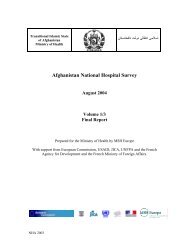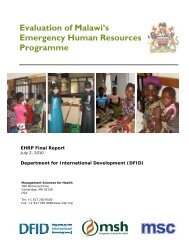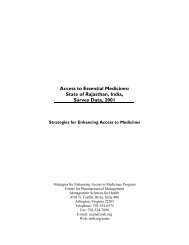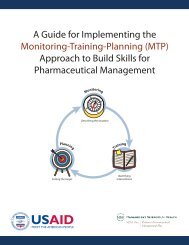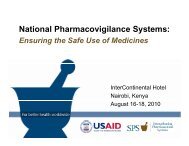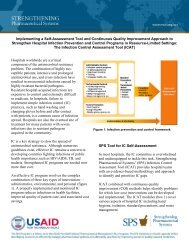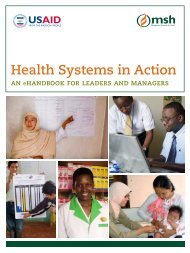CLINIC SUPERVISOR'S MANUAL - Management Sciences for Health
CLINIC SUPERVISOR'S MANUAL - Management Sciences for Health
CLINIC SUPERVISOR'S MANUAL - Management Sciences for Health
Create successful ePaper yourself
Turn your PDF publications into a flip-book with our unique Google optimized e-Paper software.
HIV/AIDS: Prevention<br />
ACRONYMS FOR HIV AND AIDS PREVENTION<br />
AIDS - Acquired immuno-deficiency syndrome<br />
HIV - Human immuno-deficiency virus<br />
PHC - Primary health care<br />
STD - Sexually transmitted disease<br />
STI - Sexually transmitted infection<br />
Why is HIV and AIDS prevention such a high priority now?<br />
Because:<br />
� HIV is the virus that causes AIDS, the disease.<br />
� Prevalence of HIV infection is high and rising in each community in the whole country. HIV<br />
infection has reached epidemic level, meaning it affects many people and is spreading.<br />
� Prevention of transmission of HIV is the only way to prevent death from AIDS.<br />
� Nurses and other health workers at primary care facilities and other settings of care are critical<br />
agents <strong>for</strong> HIV prevention. Daily, they interact with many clients, young, middle-aged and old,<br />
who may not as yet have accurate in<strong>for</strong>mation about HIV or AIDS.<br />
How can clinic nurses support ef<strong>for</strong>ts towards prevention of HIV?<br />
A clinic nurse should use any contact with a client to help them build their skills <strong>for</strong> HIV prevention<br />
by:<br />
� Educating the clients and creating awareness about HIV and AIDS prevention. This would<br />
include explaining what HIV and AIDS are and how HIV is spread, making individuals aware<br />
that protecting themselves is the only way to protect their partner or unborn child,<br />
� Explaining what options they have <strong>for</strong> reducing risk of acquiring the virus.<br />
� Counselling clients on HIV prevention by promoting safer sexual behaviour.<br />
� Referring at-risk clients <strong>for</strong> voluntary counselling and testing.<br />
� Taking responsibility <strong>for</strong> prompt, correct and full treatment of persons with STIs.<br />
� Promoting and encouraging condom use <strong>for</strong> sexually active individuals.<br />
� Observing universal precautions of infection prevention at work in order to decrease own<br />
chances of exposure to infected blood or other body fluids, although the risk is said to be<br />
small.<br />
What key messages about HIV and AIDS should client education highlight?<br />
� HIV attacks and eventually impairs blood cells in the body that normally fight infection - in the<br />
end, the body cannot defend itself against various other infections. For example, bacterial<br />
infections become more severe, last longer and become harder to treat with antibiotics.<br />
� The virus is transmitted when body fluids like semen, blood, and vaginal fluids of an infected<br />
person get into the body of another person. Transmission could occur via sexual intercourse,<br />
blood transfusion, unclean needles or syringes, (or any tool that cuts or pricks the skin), and<br />
mother to her baby during pregnancy, childbirth or breast-feeding.<br />
� Most infections are through sexual intercourse.<br />
� Anyone who practices unsafe sex can get HIV/AIDS.<br />
� Even if you are faithful you can get HIV/AIDS if your partner has other sex partners who are<br />
infected with the virus.<br />
� Most people infected by HIV do not know they are infected until many years later when they<br />
develop symptoms of AIDS. One cannot tell who is infected by HIV simply by looking at them.<br />
� STDs greatly increase the risk of acquiring HIV/AIDS.<br />
16 Clinic Supervisor’s Manual




